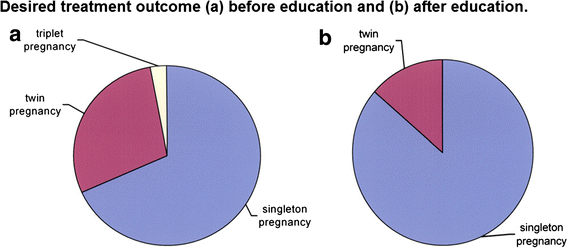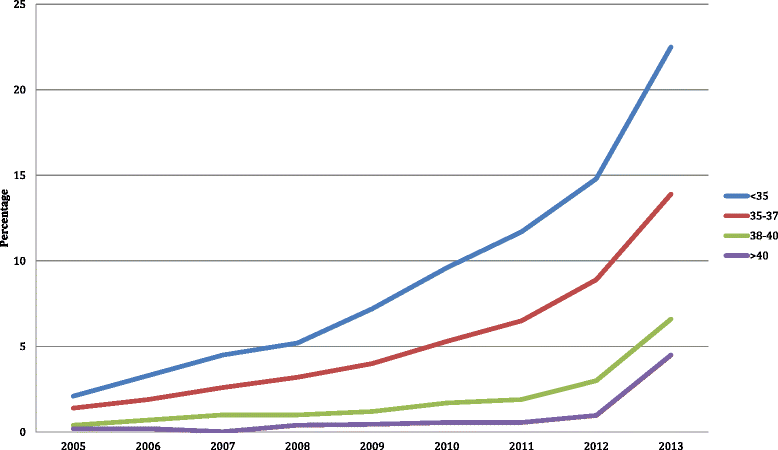Elective single embryo transfer- the power of one
- PMID: 29201400
- PMCID: PMC5693485
- DOI: 10.1186/s40834-016-0023-4
Elective single embryo transfer- the power of one
Abstract
Despite the highest historical live birth success rates for couples undergoing in vitro fertilization (IVF), there has been an epidemic of iatrogenic twin and higher order gestation conceived from this treatment. Continued improvement in cryopreservation techniques have allowed preservation of supernumerary embryos for use in future cycles, and refinements in culture systems and embryo selection have resulted in the transfer of fewer embryos while maintaining favorable pregnancy rates. The voluntary transfer of a single high quality embryo, elective single embryo transfer (eSET), has significantly reduced multiple gestation rates and maximized the rate of singleton pregnancy without compromising overall success rates. Although eSET is the standard of care in several developed countries, utilization in the United States has been slow. States with mandated IVF insurance have seen decreases in preterm birth rates yielding down stream health care savings. Herein, the evolution and future applications of this practice to reduce the risk of iatrogenic twins is reviewed.
Keywords: Elective single embryo transfer; In-vitro fertilization; Infertility; Twin gestation assisted reproductive technology.
Figures


Similar articles
-
Assisted Reproductive Technology Surveillance — United States, 2012.MMWR Surveill Summ. 2015 Aug 14;64(6):1-29. MMWR Surveill Summ. 2015. PMID: 26270152
-
Assisted reproductive technology surveillance--United States, 2011.MMWR Surveill Summ. 2014 Nov 21;63(10):1-28. MMWR Surveill Summ. 2014. PMID: 25412164
-
Assisted Reproductive Technology Surveillance - United States, 2013.MMWR Surveill Summ. 2015 Dec 4;64(11):1-25. doi: 10.15585/mmwr.ss6411a1. MMWR Surveill Summ. 2015. PMID: 26633040
-
Guidelines for the number of embryos to transfer following in vitro fertilization No. 182, September 2006.Int J Gynaecol Obstet. 2008 Aug;102(2):203-16. doi: 10.1016/j.ijgo.2008.01.007. Int J Gynaecol Obstet. 2008. PMID: 18773532 Review.
-
Attitudes towards single embryo transfer, twin and higher order pregnancies in patients undergoing infertility treatment: a review.Hum Fertil (Camb). 2010 Mar;13(1):28-34. doi: 10.3109/14647270903586364. Hum Fertil (Camb). 2010. PMID: 20141337 Review.
Cited by
-
Clinical Usability of Embryo Development Using a Combined Qualitative and Quantitative Approach in a Single Vitrified-Warmed Blastocyst Transfer: Assessment of Pre-Vitrified Blastocyst Diameter and Post-Warmed Blastocyst Re-Expansion Speed.J Clin Med. 2022 Nov 29;11(23):7085. doi: 10.3390/jcm11237085. J Clin Med. 2022. PMID: 36498659 Free PMC article.
-
Clinical data-based modeling of IVF live birth outcome and its application.Reprod Biol Endocrinol. 2024 Jul 8;22(1):76. doi: 10.1186/s12958-024-01253-3. Reprod Biol Endocrinol. 2024. PMID: 38978032 Free PMC article.
-
Beyond the Inner Cell Mass: Evaluating the Impact of Inner Cell Mass Visibility on Implantation Prediction in Static Blastocyst Images - A Retrospective Cohort Study.J Hum Reprod Sci. 2025 Apr-Jun;18(2):80-88. doi: 10.4103/jhrs.jhrs_63_25. Epub 2025 Jun 28. J Hum Reprod Sci. 2025. PMID: 40740623 Free PMC article.
-
Evaluation of the expression profile of mRNAs and lncRNAs in cumulus cells associated with polycystic ovary syndrome and pregnancy.Iran J Basic Med Sci. 2023;26(10):1144-1154. doi: 10.22038/IJBMS.2023.67564.14806. Iran J Basic Med Sci. 2023. PMID: 37736513 Free PMC article.
-
The Effectiveness of Routine Cerclage in In Vitro Fertilization (IVF) Twins.Cureus. 2024 Jul 25;16(7):e65328. doi: 10.7759/cureus.65328. eCollection 2024 Jul. Cureus. 2024. PMID: 39184593 Free PMC article.
References
Publication types
LinkOut - more resources
Full Text Sources
Other Literature Sources

